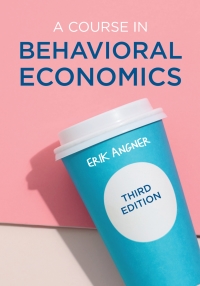shows. A person who ignores the opportunity cost of a bad relationship, for example, could miss out
Question:
shows. A person who ignores the opportunity cost of a bad relationship, for example, could miss out on a lot. If you were surprised by the opportunity costs of watching the “Gangnam Style” video, chances are you underestimated them. Here is another example. Example 3.8 Ignoring opportunity costs Imagine that after visiting your parents in Kansas a few times, you earn a voucher that can be exchanged for a free airplane ticket anywhere in the country. You decide to go to Las Vegas. You would not actually have bought a ticket to Vegas, but because it was free you figured you might as well. Now you would like to visit your parents in Kansas, and wish you did not have to pay so much money for the ticket. In this case, you may be acting irrationally because you did not consider the opportunity cost of using the ticket to go to Vegas. Insofar as you would have preferred to use the voucher to visit your parents in Kansas, you failed to consider what you could have used it for instead. Though the ticket was purchased using a voucher rather than cash, the decision to use it to go to Vegas is associated with a substantial opportunity cost. As this example illustrates, people are particularly likely to ignore the opportunity cost of spending a windfall, that is, an unexpectedly large or unforeseen profit. Yet the best way to spend a dollar is not a function of how it ended up in your pocket. What follows is a classic example. There are two different versions of this question, one with the original numbers and one with the numbers in square brackets. Example 3.9 Jacket/calculator problem Imagine that you are about to purchase a jacket for $125 [$15], and a calculator for $15 [$125]. The calculator salesman informs you that the calculator you wish to buy is on sale for $10 [$120] at the other branch of the store, located 20 minutes’ drive away. Would you make the trip to the other store? In the original study, 68 percent of respondents were willing to make the drive to save $5 on the $15 calculator. Yet only 29 percent were willing to make the drive to save $5 on the $125 calculator. Here, many respondents seem to have failed to take opportunity costs properly into account. Standard theory requires you to make your decision based on the opportunity cost of the 20-minute drive. The opportunity cost does not depend on how you saved the $5. If people took the opportunity cost properly into account, therefore, they would drive in the one scenario just in case they would drive in the other. But that is not what we observe.
Step by Step Answer:







